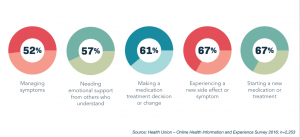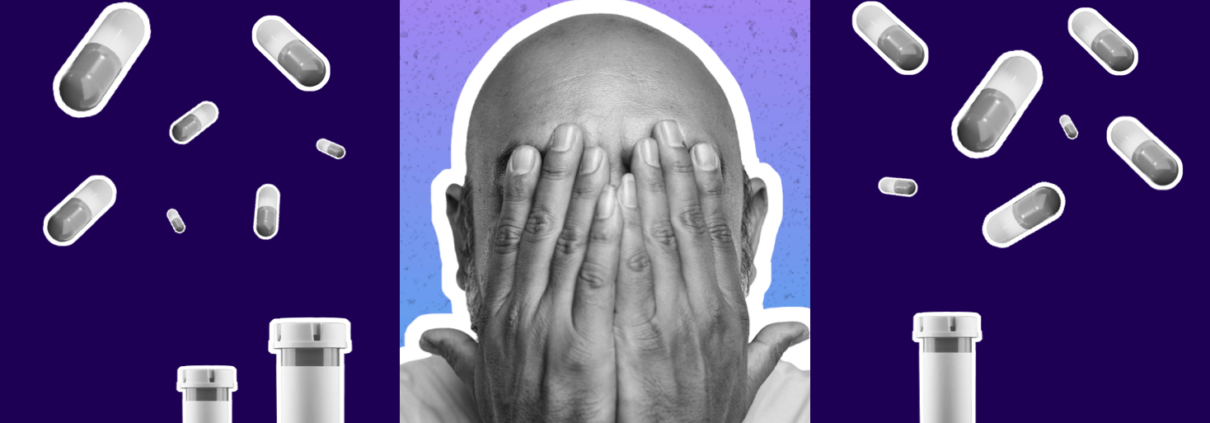Anyone impacted by a chronic health condition can visit any Health Union site at any time and easily find the support, information and connection they are looking for. Health Union delivers unique content and tools to encourage, enable and evolve social interactions into valuable health conversations.
David Shronk, Health Union SVP of Media, has talked a lot about the post-cookies fate and the impact to pharma–check out his piece in DTC Perspectives.
Adjust your strategies to break through the noise
2020 challenged all of us in many ways, forcing us to rethink and revisit trusted plans and strategies on the fly. With Americans spending more time on screens than before the pandemic, marketers have the ongoing challenge to break through the noise and capture attention more effectively.
In order to reach and connect with someone experiencing life with a chronic condition, marketers are adjusting their pre-COVID strategies to be relevant today. Take the omnichannel customer journey for example: Omnichannel marketing puts the patient at the center. It recognizes that people like choices and this approach offers a seamless, unified experience that puts them at the center, not the product.
 This shift to omnichannel due to a fragmentation of devices and attention span requires marketers to shift their thinking from determining which tactics drive behavior to understanding how the experience across all of the channels work together to drive behavior. Recent Health Union survey data shows 60% of people with chronic conditions use more than two devices to watch or stream TV. And it’s not just Gen Z and Millennials–the move away from cable/satellite into cord cutting is happening across the generations.
This shift to omnichannel due to a fragmentation of devices and attention span requires marketers to shift their thinking from determining which tactics drive behavior to understanding how the experience across all of the channels work together to drive behavior. Recent Health Union survey data shows 60% of people with chronic conditions use more than two devices to watch or stream TV. And it’s not just Gen Z and Millennials–the move away from cable/satellite into cord cutting is happening across the generations.
Driving interest in a prescription therapy takes education and motivation, at a point in time when those messages are most relevant. Media habits have shifted and, given the environment, it’s time for pharma marketers to think more critically about how to reach people. If commercial breaks equate to social media time and fragmented media drives fragmented attention that disrupts delivery, the solution is to integrate and connect the experiences.
Be present around interactive, personal content
Marrying TV viewing, online search and social in a way that is relevant to consumers’ media habits – and the context that supports those habits – ensures pharma marketers can be there when people are open to accepting the messages. This ultimately exemplifies the understanding of what people want. Connecting the experiences, instead of pushing a message when the consumer isn’t receptive, will be the difference between enhancing versus undermining consideration.
Health Union’s online health communities not only offer a large repository of condition-specific information but the real and raw stories from others living with these conditions are the backdrop for providing the nuanced and personal content they want to not feel alone in their journey.
Real and raw stories from people living with chronic conditions are the backdrop for providing nuanced and personal content people want to not feel alone in their health journey. The video here demonstrates how Health Union’s online health communities not only offer a large repository of condition-specific information but the right content that helps industry partners reach and engage patients in the most relevant and meaningful ways.
Put the person first
The COVID-19 pandemic has presented many obstacles, yet the healthcare industry continues to march forward to meet patients where they are. With physical distancing, new office protocols and the widespread use of telehealth, the patient experience is changing–particularly for people living with chronic conditions, who may require more regular access to care. With more access points, and more ways to reach people, pharma marketers have a great opportunity to put the individual person first and remain personal and supportive in health communications.
LungCancer.net advocate Lisa Moran made it clear in a recent virtual Q&A that she wants to hear about first hand treatment experience. She shared a story about a friend with lung cancer who was invited to speak on a panel about a stage I clinical trial. While her friend discussed her experience with the clinical trial drug, she was cut off by a doctor who began speaking about what it was like to take the drug, without having experienced it himself.
The same goes for advertising–when she has the chance, Lisa actively participates in advisory groups knowing that they may be used to develop messaging. The voice of the patient, including the real words used to describe their experience or a given product, have the potential to better resonate than the words someone without the lived experience thinks they would use.




